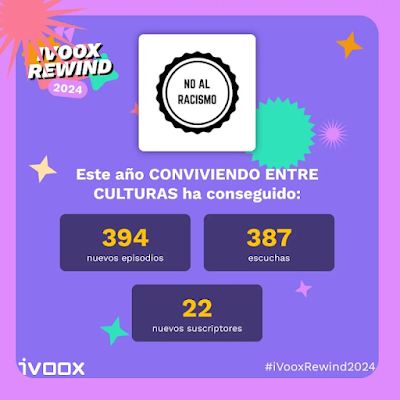Bienvenidos a este episodio . Hoy tenemos un pequeño punto de encuentro para explorar historias, experiencias y perspectivas que nos unen a través de las diferencias.
Para el episodio de hoy, dentro de la sección" RATÓN DE BIBLIOTECA", noy no les hablaré de un libro, sino de las adaptaciones cinematográficas. He visto unas cuantas y pocas son las que guardan un rigor fidedigno ni con la obra original ni con la historia real.
A mi me gusta informarme sobre los autores o autoras porque me ayudan con el contexto.
Lo primero que hago cuando me pongo a estudiar. Me da mucha rabia y por eso huyo de las adaptaciones.
Gracias por sintonizar Conviviendo entre Culturas ! Si disfrutaste el episodio de hoy, por favor, tómate un momento para reflexionar sobre lo explicado aquí. Si lo deseas puedes escribirme un comentario
Welcome to this episode. Today we have a small meeting point to explore stories, experiences, and perspectives that unite us across our differences.
For today's episode, within the "BOOKWORM" section, I won't be talking about a book, but rather about film adaptations. I've seen a few, and few of them maintain faithful accuracy, either with the original work or with the real story.
I like to learn about authors because it helps me with context.
It's the first thing I do when I start studying. It makes me really angry, and that's why I avoid adaptations.
Thank you for tuning in to Living among Cultures! If you enjoyed today's episode, please take a moment to reflect on what was explained here. If you wish, you can leave me a comment
Willkommen zu dieser Folge. Heute haben wir einen kleinen Treffpunkt, um Geschichten, Erfahrungen und Perspektiven zu erkunden, die uns über unsere Unterschiede hinweg verbinden.
In der heutigen Folge, in der Rubrik „BÜCHERWURM“, spreche ich nicht über ein Buch, sondern über Verfilmungen. Ich habe einige gesehen, und nur wenige bleiben dem Originalwerk oder der wahren Geschichte treu.
Ich lerne gerne etwas über Autoren, weil es mir hilft, den Kontext zu verstehen.
Es ist das Erste, was ich tue, wenn ich mit dem Lernen beginne. Es macht mich richtig wütend, und deshalb vermeide ich Verfilmungen.
Vielen Dank, dass Sie bei „Leben zwischen Kulturen“ eingeschaltet haben! Wenn Ihnen die heutige Folge gefallen hat, nehmen Sie sich bitte einen Moment Zeit, um über das hier Erklärte nachzudenken. Wenn Sie möchten, können Sie mir gerne einen Kommentar hinterlassen.
Bienvenue dans cet épisode. Aujourd'hui, nous avons un petit moment de partage pour explorer les histoires, les expériences et les perspectives qui nous unissent malgré nos différences.
Dans l'épisode d'aujourd'hui, dans la section "Rat de bibliothèque", je ne parlerai pas d'un livre, mais plutôt d'adaptations cinématographiques. J'en ai vu quelques-unes, et peu d'entre elles sont fidèles à l'œuvre originale ou à l'histoire vraie.
J'aime en apprendre davantage sur les auteurs, car cela m'aide à comprendre le contexte.
C'est la première chose que je fais quand je commence à étudier. Cela me met vraiment en colère, et c'est pourquoi j'évite les adaptations.
Merci d'avoir suivi Vivre parmi les cultures ! Si vous avez apprécié l'épisode d'aujourd'hui, prenez un moment pour réfléchir à ce qui y est expliqué. Si vous le souhaitez, vous pouvez me laisser un commentaire.
أهلاً بكم في هذه الحلقة. اليوم، نلتقي لنستكشف قصصاً وتجارب ووجهات نظر تجمعنا رغم اختلافاتنا.
في حلقة اليوم، ضمن قسم "مُحبي الكتب"، لن أتحدث عن كتاب، بل عن اقتباسات أفلام. شاهدتُ بعضها، وقليل منها حافظ على دقة عالية، سواءً في العمل الأصلي أو في القصة الحقيقية.
أُحب التعرّف على الكُتّاب لأنه يُساعدني في فهم السياق.
إنه أول ما أفعله عندما أبدأ الدراسة. يُثير غضبي، ولهذا السبب أتجنب الاقتباسات.
شكراً لمتابعتكم حلقة "العيش بين الثقافات"! إذا استمتعتم بحلقة اليوم، يُرجى تخصيص بعض الوقت للتفكير فيما شُرح هنا. يُمكنكم ترك تعليق إن رغبتم.
Aroha mai ki teie tuhaa. I teie mahana, e vahi putuputuraa na'ina'i ta tatou no te hi'opo'a i te mau aamu, te mau ohipa i tupu, e te mau mana'o o te tahoê ia tatou i roto i to tatou mau taa-ê-raa.
Eita vau e paraparau no ni'a i te hoê buka i roto i te tuhaa no teie mahana, no ni'a râ i te mau hoho'a teata. E mea iti roa ta'u i ite, e e mea iti roa o ratou o te tape'a nei i te parau-ti'a, na roto anei i te buka matamua aore râ, na roto i te aamu mau.
E mea au na'u ia haapii no ni'a i te mau papa'i buka no te mea e tauturu te reira ia'u i roto i te mau huru tupuraa.
O te ohipa matamua ïa ta'u e rave ia haamata ana'e au i te haapii. Te faatupu nei te reira i te riri rahi i nia ia ' u, e no reira vau e ape ai i te mau tauiraa.
Mauruuru no to outou amuiraa mai i roto i te oraraa i rotopu i te mau ahurea! A rave na i te hoê taime no te feruri i ni'a i te mau mea i faataahia i ô nei mai te mea e, ua au roa oe i te tuhaa o teie mahana. Mai te mea e, e hinaaro outou, e nehenehe ta outou e vaiiho mai i te hoê mana'o
Patricia López Muñoz
Técnico Superior en Animación Sociocultural
Técnico Especialista en Inmigración
Técnico Superior en Integración Social




